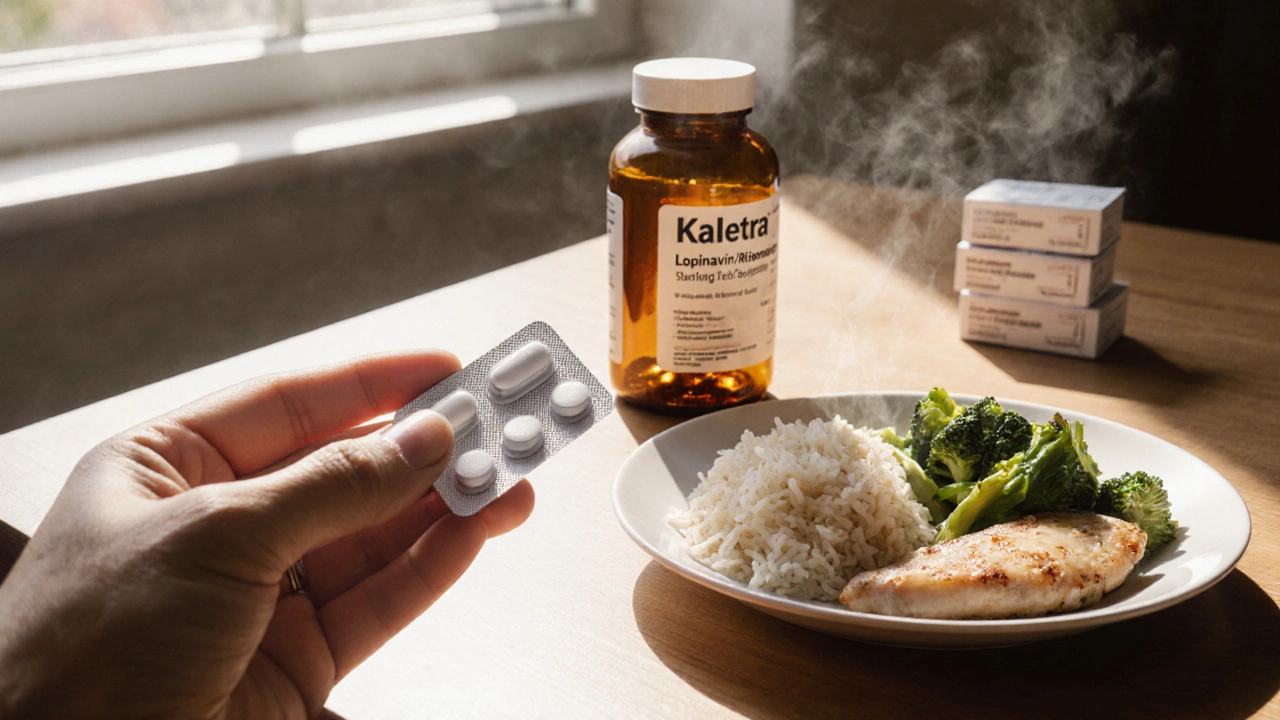HIV Treatment Decision Guide
Find the best HIV treatment for your situation
This tool helps you compare treatment options based on your specific health needs, resistance profile, dosing preferences, and cost considerations.
How This Tool Works
This decision guide uses the information from our article comparing Kaletra and alternatives to provide personalized recommendations based on your responses. We prioritize factors like:
- Drug resistance profiles
- Side effect profiles
- Dosing frequency and convenience
- Cost considerations
- Pregnancy considerations
Remember: This is not a substitute for medical advice. Always discuss treatment options with your healthcare provider.
Quick Takeaways
- Kaletra combines two protease inhibitors and is still a solid option for treatment‑experienced HIV patients.
- Newer agents like bictegravir‑based combos offer once‑daily dosing and fewer food restrictions.
- Cost and drug‑resistance patterns are the biggest drivers when picking an alternative.
- Atazanavir and darunavir provide comparable efficacy but differ in side‑effect profiles.
- Always match the regimen to the patient’s lifestyle, comorbidities, and insurance coverage.
When a clinician or a patient hears the name Kaletra, the first images that pop up are a bulky pill box, a strict no‑food‑until‑an‑hour‑after rule, and a price tag that can hurt the wallet. Yet the drug still shows up in many treatment plans, especially where resistance to newer agents has already built up. This article walks through what Kaletra actually is, why it was a game‑changer, and how it stacks up against the most common alternatives on the market today. By the end you’ll know exactly when Kaletra makes sense and when an alternative will likely give a smoother ride.
What Is Kaletra?
Kaletra is a fixed‑dose combination of two protease inhibitors: Lopinavir and Ritonavir. Lopinavir is the main antiviral agent, while ritonavir is used at a low dose to boost lopinavir’s blood levels by inhibiting the CYP3A4 enzyme that would otherwise break it down quickly.
Approved by the FDA in 2000, Kaletra quickly became a cornerstone of antiretroviral therapy (ART) for adults and children living with HIV. The combination is taken as two tablets taken with a meal, typically twice a day, which helps maintain steady drug concentrations throughout the day.
How Kaletra Works
Both lopinavir and ritonavir belong to the protease‑inhibitor class. HIV protease is an enzyme the virus needs to cleave long protein chains into functional pieces that assemble new viral particles. By blocking this enzyme, the drugs prevent the virus from maturing, halting replication.
Ritonavir’s boosting effect works because it’s a potent inhibitor of the liver enzyme CYP3A4. When co‑administered, it slows the metabolism of lopinavir, raising its plasma concentration without needing a higher dose of lopinavir itself. This pharmacokinetic trick lets patients stay on a manageable pill burden while keeping viral suppression.
When Kaletra Is Used
Kaletra is most often prescribed for:
- Patients who have developed resistance to first‑line integrase‑strand transfer inhibitors (INSTIs) or non‑nucleoside reverse transcriptase inhibitors (NNRTIs).
- Pregnant women where the benefit outweighs the risk, as Kaletra has a well‑established safety record in pregnancy.
- Resource‑limited settings where newer drugs are either unavailable or prohibitively expensive.
The World Health Organization still lists Kaletra as a preferred second‑line regimen in many low‑ and middle‑income countries, mainly because the drugs are off‑patent and generic versions are cheap.
Common Alternatives to Kaletra
Over the last decade, several newer agents have entered the market, offering once‑daily dosing, fewer food restrictions, and improved tolerability. The most frequently considered alternatives are:
- Atazanavir (boosted with ritonavir or cobicistat) - a protease inhibitor with a lower lipid‑raising profile.
- Darunavir (ritonavir‑boosted) - another powerful protease inhibitor that retains activity against many lopinavir‑resistant strains.
- Integrase‑strand transfer inhibitor (INSTI) combos such as Bictegravir/Emtricitabine/Tenofovir alafenamide (Biktarvy) - the current gold‑standard for first‑line therapy due to high barrier to resistance and minimal drug‑food interactions.
- Generic lopinavir/ritonavir tablets - essentially the same chemistry as Kaletra but often sold in bulk, reducing cost.
Head‑to‑Head Comparison
| Attribute | Kaletra (LPV/r) | Atazanavir (ATV/r) | Darunavir (DRV/r) | Bictegravir‑based combo |
|---|---|---|---|---|
| Drug class | Protease inhibitor | Protease inhibitor | Protease inhibitor | Integrase inhibitor |
| Typical dosing | 2 tablets BID with food | 1 tablet QD with food | 1 tablet BID with food | 1 tablet QD, no food restriction |
| Pill burden | 4 tablets per day | 1 tablet per day | 2 tablets per day | 1 tablet per day |
| Common side effects | GI upset, hyperlipidaemia, taste changes | Jaundice, mild GI upset | Diarrhoea, rash, elevated lipids | Insomnia, headache (rare), low kidney impact |
| Food requirement | Must be taken with a meal | Meal‑dependent for absorption | Meal‑dependent for absorption | No specific requirement |
| Resistance barrier | Moderate - susceptible to PI mutations | High - preserves activity | Very high - works against many PI‑resistant viruses | Very high - integrase driver |
| Average monthly cost (US$) | ~30 (generic) | ~80 (brand) / 20 (generic) | ~120 (brand) / 30 (generic) | ~150 (brand) |
Pros and Cons of Each Regimen
Kaletra
- Pros: Proven efficacy in treatment‑experienced patients; cheap generic options; extensive safety data in pregnancy.
- Cons: Twice‑daily dosing; high pill count; food‑timing requirement; notable lipid‑raising effect.
Atazanavir
- Pros: Once‑daily dosing; lower impact on cholesterol; relatively mild GI profile.
- Cons: Can cause indirect hyperbilirubinemia (jaundice); still needs a booster (ritonavir or cobicistat); cost varies by brand.
Darunavir
- Pros: High barrier to resistance; effective against many PI‑resistant strains; good option for patients with prior protease‑inhibitor failure.
- Cons: Requires ritonavir boosting; twice‑daily dosing; higher cost; can raise lipids.
Bictegravir‑based combo
- Pros: Once‑daily single‑tablet regimen; minimal drug‑food interactions; excellent resistance profile; little impact on lipids.
- Cons: Highest price point; not ideal for patients with severe renal impairment (due to tenofovir alafenamide component); limited data in pregnancy.
Decision Factors to Match Patient Needs
Choosing the right regimen isn’t just about the drug’s potency. Consider these practical dimensions:
- Resistance profile: If the viral genotype shows PI mutations, darunavir or an INSTI‑based combo may be safer.
- Pill burden and dosing frequency: Patients with chaotic schedules often benefit from once‑daily, single‑tablet options.
- Food restrictions: Some patients can’t guarantee a meal before each dose. Kaletra and atazanavir require food, whereas bictegravir does not.
- Side‑effect tolerance: Those with pre‑existing hyperlipidaemia might avoid Kaletra or darunavir; those prone to jaundice may steer clear of atazanavir.
- Cost and insurance coverage: Generic lopinavir/ritonavir remains the cheapest, which can be decisive in public‑health programs.
- Pregnancy considerations: Kaletra has the most robust data for use during pregnancy; bictegravir data is still emerging.
Practical Tips for Patients on Kaletra or Alternatives
- Take with a meal: Even a light snack improves absorption and reduces nausea.
- Watch lipid panels: Schedule blood tests every 3-6 months if on protease inhibitors.
- Stay hydrated: Some protease inhibitors can cause dry mouth; water helps.
- Check for drug interactions: Ritonavir is a strong CYP3A4 inhibitor; avoid over‑the‑counter meds like certain antihistamines or St.John’s wort.
- Use pill organizers: For twice‑daily regimens, a simple day/night compartment reduces missed doses.
- Discuss switch options early: If side effects become intolerable, ask the clinician about moving to an INSTI‑based combo.
Frequently Asked Questions
Is Kaletra still recommended for new HIV patients?
For treatment‑naïve individuals, current guidelines favour integrase‑strand transfer inhibitor regimens like bictegravir/tenofovir/emtricitabine because they are simpler and have fewer metabolic side effects. Kaletra is usually reserved for patients who have already failed other lines or who need a low‑cost option.
Can I switch from Kaletra to a once‑daily pill without a break?
Yes, most clinicians perform a direct switch to an INSTI‑based single‑tablet regimen, provided the patient’s viral load is suppressed and resistance testing is clear. A brief “wash‑out” isn’t needed; just follow the new regimen’s dosing schedule.
Why does Kaletra cause a metallic taste?
Ritonavir can interfere with taste buds, leading to a metallic or bitter sensation. Taking the tablets with a larger meal or a flavored beverage often masks the taste.
Are there any major drug interactions with ritonavir?
Ritonavir is a potent CYP3A4 inhibitor, so it can raise levels of many drugs such as certain statins, anti‑arrhythmics, and some anticonvulsants. Always check with a pharmacist before starting new prescription or over‑the‑counter meds.
How does the cost of generic Kaletra compare to branded alternatives?
Generic lopinavir/ritonavir can be as low as US$30 a month in many countries, whereas branded atazanavir, darunavir, or bictegravir combos often exceed US$100‑150. Insurance coverage and government subsidy programs can narrow the gap, but generics remain the most affordable option.







mike tallent
October 13, 2025 AT 21:38Joyce Genon
October 15, 2025 AT 05:14Rob Goldstein
October 17, 2025 AT 03:20Deepali Singh
October 17, 2025 AT 05:12George Gaitara
October 18, 2025 AT 21:10Julie Roe
October 20, 2025 AT 20:29Peter Stephen .O
October 22, 2025 AT 17:10Andrew Cairney
October 23, 2025 AT 22:49jalyssa chea
October 24, 2025 AT 12:39Sylvia Clarke
October 25, 2025 AT 00:12Abdul Mubeen
October 26, 2025 AT 06:42John Wayne
October 28, 2025 AT 04:12vinod mali
October 29, 2025 AT 17:05Kathy Grant
October 31, 2025 AT 16:52Jennie Zhu
November 1, 2025 AT 08:48Jennifer Howard
November 2, 2025 AT 14:36